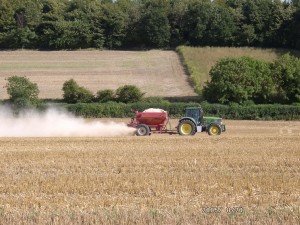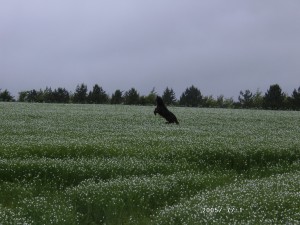|
|
Three inches of rain on malting barley that is ready to harvest is not funny. It being the first of August and with over 1300 acres still to cut, you can’t expect me not to mention the weather. The whole point of malting barley when it has been harvested, dried, stored for a while and then delivered to a maltings, is that it will actually germinate, so that the enzymes in the grain will convert the starch in the grain to sugar, which if growing into a plant, gives it the energy to grow, but if being used by wicked humans to turn into beer, is used to feed the yeast in the fermentation process that produces alcohol. Once malting barley is properly ripe, it must be harvested and dried promptly, or else the germination will deteriorate. Repeated soaking, drying, soaking and warmth will of course trigger germination, even in the ear. 98% germination, or sometimes 96% is required for most malting contracts, if this cannot be met then the barley is only fit for animal feed.
When we send a lorry load of barley to a maltings, just 50 grains are examined to decide whether the load is of sufficient quality to accept or reject for germination, 49 of them must pass (98%). A 29 ton lorry will contain around 800 million grains of barley.
Needless to say there is also a price consequence, the best quality malting barley is worth over £100 per ton, feed barley only around £60. On a potential 1000 tons per year that is a lot of difference, and all down to the weather. Now you know why farmers have an interest in the weather!
Meanwhile, let us try to remain optimistic, the winter barley that is already safely in the barn looks to be of good enough quality from initial tests, and the yield was better than the last two years. The winter oilseed rape is all in too, with a useful looking yield, well up on last years dismal performance.
Whilst it has been too wet for harvesting, there has been plenty of other work to keep us busy, mowing off the long rape stubble prior to cultivations, and tidying up scruffy pastures, with a very superior hired mower much better than we own. Also our contractor has been spreading ground chalk on some fields, to counteract acidity brought on by fertiliser use on clay-cap soils. 
A couple of the cattle in the meadows have been suffering from new forest eye, a nasty condition spread by flies, which clouds the covering of the eye, and needs to be treated with an injection of antibiotic and steroid in the eyelid. This means getting them all into the handling yard every time someone needs treatment, and needs a steady hand.
last month back to 2015 next month



